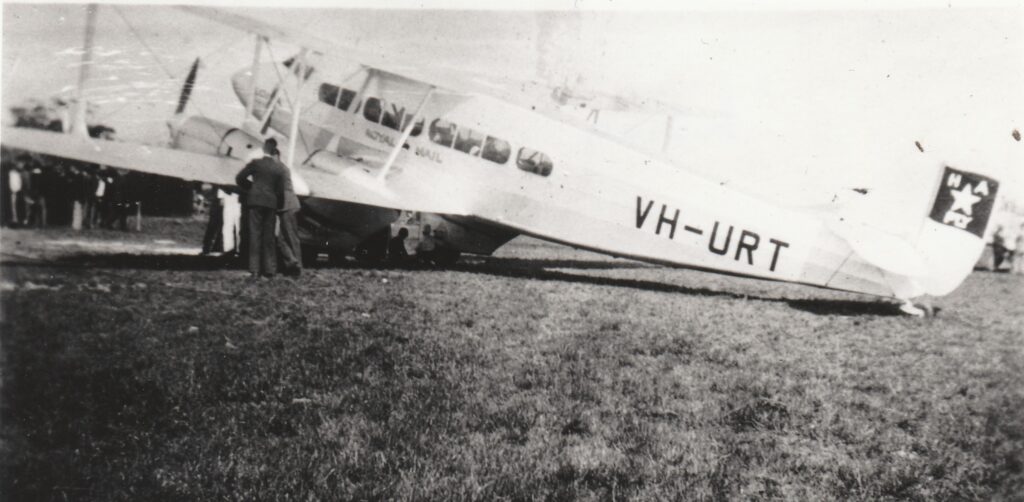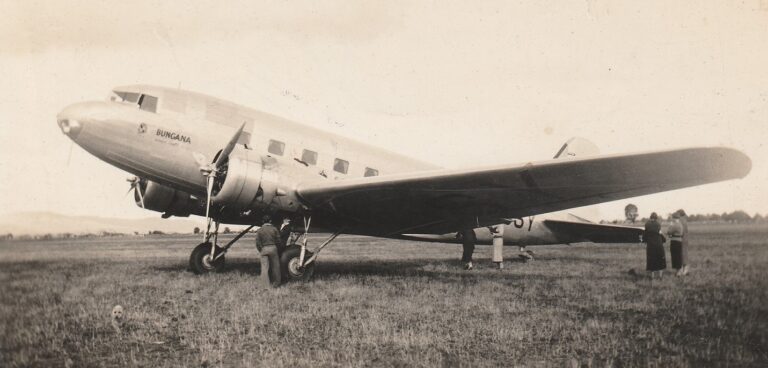Bass Straight airmail and passenger services increased in 1934, but unfortunately, there were also lives lost.
![DH.84 'Miss Launceston' flying over Inveresk, Launceston [Weekly Courier]](https://bassstraitflight.au/wp-content/uploads/2022/11/Expansion-3.jpg)
1934 – 1935
Expanding Bass Strait Passenger and Mail Services
In 1934, Tasmanian Aerial Services was renamed Holyman’s Airways. They added a second plane to the Bass Strait service.
With the airmail subsidy secured, Tasmanian Aerial Services orders the new 10-seater, 4-engined de Havilland DH.86 ‘Express’ aircraft.
The company was renamed as Holyman’s Airways when Lawrence Johnson left to become an Aero Club pilot instructor. The company was then restructured to bring in more investors to expand its operation. Victor Holyman was their Chief Pilot and Managing Director.
On 1 October 1934, a new 12-seater, 4-engined de Havilland DH.86 Express was introduced. The plane was named Miss Hobart, VH-URN. The DH.86 was a four-engined biplane constructed of plywood and canvas. It was a bigger version of the twin engined Miss Launceston.
Miss Hobart and Miss Launceston, operated six crossings of Bass Strait per week, each plane flying one crossing per day
Holyman’s obtained the first DH.86 sold, which had single pilot cockpit. Later planes had a dual pilot cockpit. It had a crew of two, the pilot and the radio operator, with accommodation for 12 passengers.

1934
The First Tragedy – Loss of MISS HOBART
The first of the new de Havilland DH.86 Express airliners of Holyman’s Airways crashed into Bass Strait, with all lives lost.
A few weeks after its introduction, Miss Hobart was lost in Bass Strait near Wilson’s Promontory on 19 October 1934. It departed Western Junction at 9 a.m. for Melbourne on a direct flight. The plane made regular radio reports. The last report was received at 10.20 a.m. when it was over Rodondo Island, 10 km south of Wilson’s Promontory.
The plane was lost in the sea. An extensive search was undertaken, with only small fragments of wreckage found. Pilot Gilbert Jenkins, radio operator Victor Holyman (the Chief Pilot and Managing Director of Holyman’s Airways) and the 9 passengers all died. This was the worst air accident in Bass Strait.
With the death of his brother, Ivan Holyman then became the Managing Director of Holyman’s Airways.
1935
Holyman’s Airways Expands Mainland Services
Holyman’s Airways expands to provide their first mainland service between Melbourne and Sydney.
In October 1935, Holyman’s Airways commence a passenger service between Melbourne and Sydney, via Canberra. This was the first service between these two cities since the demise of Kingsford Smith’s A.N.A. in 1931.
More planes were brought into service and more crew were employed. They established their base in a new hangar at Essendon Aerodrome.
With the opening of the new Cambridge aerodrome in Hobart in September 1935, the bigger DH.86 planes could fly to the south of Tasmania.
Holyman’s Airways were one of the major airlines in Australia at this time.


1935
The Second Tragedy – Loss of the LOINA
The second two of the new de Havilland DH.86 Express airliners of Holyman’s Airways also crashed into Bass Strait, with all lives lost.
The second DH.86 was named the Loina, VH-URT, coming into service across Bass Strait in early 1935.
Another tragedy hit the airline when the Loina was lost in the sea while approaching Whitemark on 2 October 1935. A witness saw it “turn upside down twice” and then fall into the sea “like a tumbling pigeon”. Although considerable debris was found, the main wreckage and the bodies were not located but some mail bags were recovered. All five on board were lost, including the co-pilot, Tasmanian Max Brown.

1936
Introducing the Douglas Air Liners onto the Bass Strait Service
Holyman’s Airways brought the first Douglas DC-2 into Australia in 1936. They named it the Bungana.
In late 1935, the Civil Aviation regulations were changed to allow planes manufactured in the United States to be registered in Australia. Holyman’s Airways orders a new Douglas DC-2.
Holyman’s Airways DC2 Bungana entered service in May 1936. It was used on the Melbourne – Launceston – Hobart and return service. Bungana is an Aboriginal word meaning ‘Chief.’
Carrying 14 passengers, the DC-2 was the first plane to employ an on-board air hostess. The bigger 21-passenger DC-3 was added to the airline’s fleet in late 1937.
On 24 July 1936, the Bungana could not land at Western Junction as the pilot could not see the landing strip. Instead, it flew on to Flinders Island landed and landed at Whitemark aerodrome. The Launceston Examiner Newspaper described the flight:
After leaving Cambridge aerodrome (Hobart) on schedule, the pilots, Messrs. F. T. Patterson and D. A. Ditchburn, were compelled to take the machine above the clouds. Low storm clouds covered Western Junction aerodrome, and the pilots continued on over Launceston in search of an opening in the clouds through which they could come down.
In view of the radio advice from the Western Junction station that the clouds were only a few hundred feet off the ground and that the visibility was poor it was too dangerous to make a blind glide through.
In search of a hole in the clouds through which the descent could be made, the machine continued on over Launceston, and eventually circled in bad weather off the coast. Thick cloud and appalling visibility made it impossible to continue the flight to Melbourne, and after two hours the flight was continued to Flinders Island, where the machine descended, to make a safe landing on the Pat’s River aerodrome
There were three passengers on the Bungana. The air hostess was Miss G. Blanch Due.
1936
Australian National Airways Formed
Holyman’s Airways merged with Adelaide Airways in mid-1936 to form Australian National Airways, (A.N.A.), with Ivan Holyman the Managing Director.
They reused the name of Charles Kingsford Smith’s earlier airline (A.N.A.) as a tribute to the pioneering aviator who had died in a plane crash in late 1935 while attempting to break the Australia to UK flight record.
A.N.A. was the largest airline in Australia at the start of the Second World War, and the 9th largest in the world at the time. Although now based in Melbourne, its roots were in Launceston.
In 1939, 13,725 passengers were flown across Bass Strait, 10,532 directly between Melbourne and Launceston, and 3,193 via Flinders or King Islands
